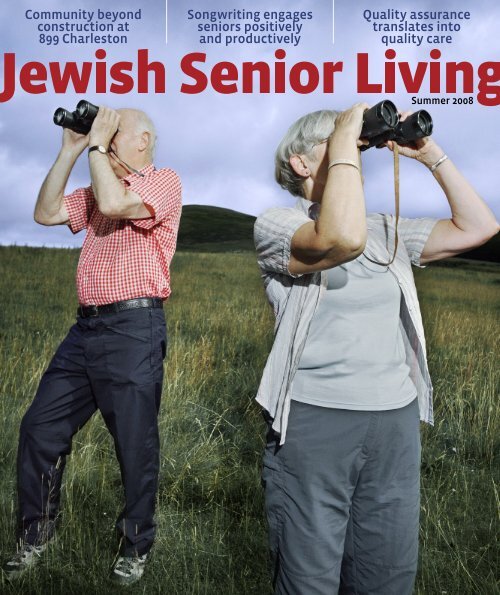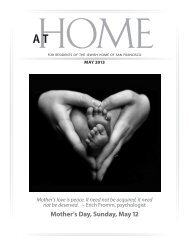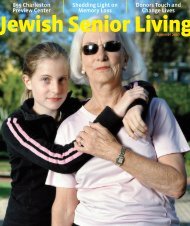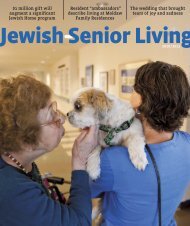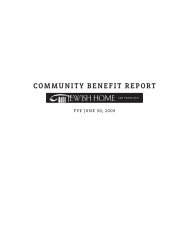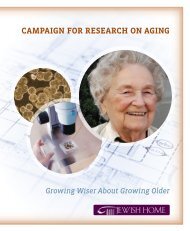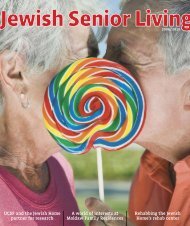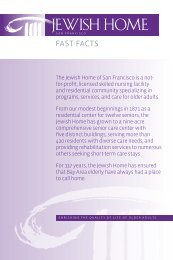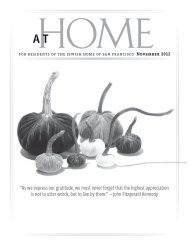Community beyond construction at 899 Charleston Songwriting ...
Community beyond construction at 899 Charleston Songwriting ...
Community beyond construction at 899 Charleston Songwriting ...
- No tags were found...
You also want an ePaper? Increase the reach of your titles
YUMPU automatically turns print PDFs into web optimized ePapers that Google loves.
<strong>Community</strong> <strong>beyond</strong><strong>construction</strong> <strong>at</strong><strong>899</strong> <strong>Charleston</strong><strong>Songwriting</strong> engagesseniors positivelyand productivelyQuality assurancetransl<strong>at</strong>es intoquality careSummer 2008
TABLE OF CONTENTSON THE HOME FRONT5 Daniel Ruth announces a new naming gift <strong>at</strong><strong>899</strong> <strong>Charleston</strong>.6 Mark Myers looks <strong>at</strong> trends in senior living.8 Arlene Krieger reminds us th<strong>at</strong> community supportenables the Jewish Home to <strong>at</strong>tend to both the bodiesand the souls of residents.9 1214 TAKING THE MEASURE OF QUALITYThe Jewish Home is stepping up its commitmentto quality through technology and a new chiefnursing executive.16 MUSIC WITH MEANINGDr. Theresa Allison believes th<strong>at</strong> seniors transcendwh<strong>at</strong> ails them when they particip<strong>at</strong>e in the Home’ssongwriting workshop.9 A TRUE MITZVAHWith pride and emotion, six from the Home celebr<strong>at</strong>ethe b’nai mitzvahs they missed in their younger years.12 MOLDAW FAMILY RESIDENCES AT<strong>899</strong> CHARLESTON BUILDS COMMUNITYBEYOND CONSTRUCTION ACTIVITYEstablishing connections, sharing interests,and meeting future neighbors.18 TIME CAPSULEWhen six presidents of the former Jewish HomeAuxiliary g<strong>at</strong>her, the subjects are fun and fundraising.21 YOGA MAVENVolunteer Sheila Lederer takes her passion for yog<strong>at</strong>o Jewish Home residents.
14Jewish Senior Living Magazinesummer 2008 vol. 3 no. 1A public<strong>at</strong>ion of the Jewish Home of San Francisco302 Silver Avenue / San Francisco, CA 94112 / www.jhsf.orgJewish Home of san franciscoBoard Of TrusteesOfficersMark Myers, ChairMichael Adler, Vice ChairJeffrey Farber, Vice ChairMichael Strunsky, Vice ChairMartin Stein, SecretaryDavid Arrick, TreasurerTrusteesBenjamin AnixterBenjamin EislerEric FastiffDonald A. FriendMilton GreenfieldStephan KriegerCarol S. RobertsAlan SilvermanJoan ZimmermanSenior ManagementDaniel R. Ruth, President & Chief Executive OfficerEdwin Cabigao, Chief Nursing ExecutiveMark Denton, Director of DevelopmentSherie A. Koshover, Director of Corpor<strong>at</strong>e PlanningJay S. Luxenberg, M.D., Medical DirectorAileen Munoz, Director of Human ResourcesKevin T. Potter, Director of FinanceSandra C. Simon, Administr<strong>at</strong>orJerry A. Levine, Executive Director EmeritusPast ChairsLeonard B. BergerJames A. Davis, M.D.David A. FriedmanFrances D. GreenDouglas M. HellerArlene E. KriegerWilliam J. LowenbergVictor L. MarcusBarbara C. Rosenberg, Ph.D.Richard M. RosenbergStuart W. SeilerEditor and publisher:Copy editor:Writer:Contributors:Designer:Photographers:Sherie KoshoverIlana GlaunSuzan BernsMark Denton, Rabbi Sheldon Marder,Development staffMichael WicklerAlain McLaughlin, Chris DuffeyJewish Home & SENIOR LIVING found<strong>at</strong>ionBoard Of TrusteesOfficersArlene E. Krieger, ChairLarry Marks, TreasurerRichard M. Rosenberg, SecretaryTrusteesAdele CorvinDavid A. FriedmanMartin SteinDavid SteirmanJoan ZimmermanDaniel R. Ruth, Board LiaisonThe Jewish Home of San Francisco is a beneficiary agencyof the Jewish <strong>Community</strong> Feder<strong>at</strong>ion of San Francisco,the Peninsula, Marin and Sonoma Counties.
18enriching the quality of life of older adults
Daniel RuthI have a gre<strong>at</strong> deal of exciting newsto share with you in this issue ofJewish Senior Living, including severalmilestones about <strong>899</strong> <strong>Charleston</strong>,our senior living community under<strong>construction</strong> on the Taube KoretCampus for Jewish Life in Palo Alto.Firstly, I am very pleased to announce th<strong>at</strong> the newproject will be named Moldaw Family Residences<strong>at</strong> <strong>899</strong> <strong>Charleston</strong>, thanks to a significant andvery generous contribution by Stuart and PhyllisMoldaw. The Moldaws are dedic<strong>at</strong>ed supporters ofthe Jewish Home of San Francisco, and Stuart hasserved on the Home’s board of trustees. It has beenStuart’s long-standing dream and goal to have asenior residence on the South Peninsula to servethe area’s large Jewish popul<strong>at</strong>ion. We are thrilledth<strong>at</strong> Stuart and Phyllis have made this commitmentand th<strong>at</strong> they will be involved in this leading-edgeresidence for older adults.Moldaw Family Residences <strong>at</strong> <strong>899</strong> <strong>Charleston</strong>is one part of a larger str<strong>at</strong>egy adopted by ourboard last year as a result of the Jewish Home’scomprehensive str<strong>at</strong>egic visioning initi<strong>at</strong>ive. Our‘Vision St<strong>at</strong>ement’ calls on us to become a regionalresource for senior adults, to provide life-enrichingprograms and services along with communityconnections, in an environment th<strong>at</strong> reflects thesocial, cultural, and spiritual values of Jewishtradition. I believe you will find th<strong>at</strong> Moldaw FamilyResidences fulfills this vision as our first foray intoregionaliz<strong>at</strong>ion.Situ<strong>at</strong>ed on a campus th<strong>at</strong> includes the Oshman FamilyJewish <strong>Community</strong> Center, Moldaw Family Residencesoffers an inviting, multi-gener<strong>at</strong>ional ‘neighborhood.’Residents will have access to JCC programs, as well asspecific activities within their own apartment buildings.Future residents are choosing from a variety of units <strong>at</strong><strong>899</strong> <strong>Charleston</strong>, each designed with amenities to supporthealthy aging.“Philanthropic support from individualssuch as the Moldaws and members of thecommunity … enable us to bring our visionto reality, ensuring th<strong>at</strong> we are responsiveto the desires and needs of older adults.”Philanthropic support from individuals such as theMoldaws and members of the community, who have madecommitments to Moldaw Family Residences and the JewishHome, enable us to bring our vision to reality, ensuring th<strong>at</strong>we are responsive to the desires and needs of older adults.With your particip<strong>at</strong>ion, we will continue to provide st<strong>at</strong>eof-the-artfacilities, services, and programs th<strong>at</strong> reflect theadvances influenced by demographic trends and the lives ofour community’s seniors.As Jewish Senior Living goes to press, our communityhas raised 95 percent of the minimum fundraising goal forthe Taube Koret Campus for Jewish Life’s capital campaign,or $134 million of the $140 million target. I say ‘minimum’because if we can raise more, we will be able to lower ourlong-term debt and thus better serve the community.Construction of Moldaw Family Residences is progressingon schedule with a completion d<strong>at</strong>e of September 9, 2009.The total project mass is 310,000 square feet, comprised ofsix four-story buildings. If you happen to stop by the site,you will see th<strong>at</strong> concrete work is nearly complete, andwindow and other glass install<strong>at</strong>ions are underway.You may also be interested to know th<strong>at</strong> the budget forthe entire Taube Koret Campus for Jewish Life is $307 million,making it the largest and most successful fundraisingcampaign in the history of the Bay Area Jewish community –and possibly the largest project undertaken by any Jewishcommunity in this country.We are thrilled to be a viable and dynamic part of thiswonderful new center for Jewish life on the South Peninsula.We thank you for the essential part you are playing th<strong>at</strong>ensures our ability to provide Bay Area elders with theongoing services they need and deserve today, and those wemay plan and implement for future years.Daniel RuthPresident & Chief Executive Officer,Jewish Home of San Franciscosummer 2008Jewish Senior Living5
It is with tremendous pride th<strong>at</strong> I serve as chair of theJewish Home of San Francisco’s board of trustees. Fornearly 137 years, from one gener<strong>at</strong>ion to the next, theJewish Home has been a vibrant community in whichthe lives of the residents are enriched by the provisionof high quality care, services, and programs.Throughout the Home’s venerable history, the community’sextraordinary commitment to caring for our older adults withdignity and respect has been unwavering. We remain gr<strong>at</strong>eful toour community for this unparalleled level of support. Without it,the Home simply would not be able to provide the level of care andassistance th<strong>at</strong> our community expects and th<strong>at</strong> our residentsdeserve.Yet, in recent years, providing for our community’s older adultshas become increasingly more complex and challenging. The healthneeds of elders are more profound, people are living longer, and thoseseeking our services arrive with gre<strong>at</strong>er frailties than ever before.Government funding is inadequ<strong>at</strong>e and far less dependable as thedifferent levels of government grapple with their own unprecedenteddeficits. In addition, the cost of providing health care continues tomount, while general infl<strong>at</strong>ionary pressures are escal<strong>at</strong>ing <strong>at</strong> r<strong>at</strong>esth<strong>at</strong> are not being m<strong>at</strong>ched by government support.“The intent of this initi<strong>at</strong>ive is to establish aworld-class center for aging services in SanFrancisco th<strong>at</strong> builds upon our reput<strong>at</strong>ionfor innov<strong>at</strong>ion, clinical and service excellence,research, educ<strong>at</strong>ion, and advocacy.”For its part, the Jewish Home’s leadership recognizes the changingworld in which we oper<strong>at</strong>e and is fully poised to dynamically respondto ensure the relevancy and viability of our programs, services, andfacilities throughout the 21st century. It is in this regard th<strong>at</strong> theJewish Home is embarking upon the re-master planning of its SilverAvenue campus. We are analyzing how we deliver services, as wellas our ability to improve and realign these services in a mannerconsistent with trends th<strong>at</strong> meet the current and future projectedneeds of those older adults seeking our services.The intent of this initi<strong>at</strong>ive is to establish a world-class centerfor aging services in San Francisco th<strong>at</strong> builds upon our reput<strong>at</strong>ionfor innov<strong>at</strong>ion, clinical and service excellence, research, educ<strong>at</strong>ion,and advocacy. The scope of this project will include but not belimited to: a facilities and building systems review; environmentalanalysis; demographic analysis; and community needs assessment.Additionally, we are collabor<strong>at</strong>ing with our Menorah Park of SanFrancisco partners in order to identify ways to extend our services tothose older adults who do not require medically-oriented services,David friedmanyet desire the convivial <strong>at</strong>mosphere of a Jewishsponsoredolder adult community. The JewishHome’s site re-master plan project is led by animpressive Steering Committee comprised of JewishHome trustees and staff, as well as communityrepresent<strong>at</strong>ion. In partnership with the Home’ssenior staff, I would like to take this opportunity toacknowledge and thank the following individualsfor serving with me on this committee: MichaelAdler, James Davis, David Friedman, Bill Pomeranz,Nurit Robinson, Joel Roos, and Michael Strunsky.I look forward to working with this outstandingcommittee and keeping you apprised of ourprogress.The Jewish Home of San Francisco remains theflagship – the emotional and cultural epicenter ofour aging initi<strong>at</strong>ives. The hallmark of the JewishHome over its long history has been the ability tore-invent itself, ensuring relevancy to its clients.As we continue this evolutionary process, we do soknowing th<strong>at</strong> opportunities can only be optimizedthrough your continued generous support.Mark MyersChair, Board of Trustees,Jewish Home of San FranciscoMark Myers6 Jewish Senior Living summer 2008
senior livingDEVELOPING SENIOR LIVING COMMUNITIESThe new trend in continuing careretirement communities – or CCRCs asthey are known in the industry – is totake away the ‘R’ for retirement, sayDan Cinelli and Leslie Moldow, principalsof the architectural and planning firmPerkins Eastman. The reason: althougholder adults may be of retirement age,these days they are still eager to beactive and involved.Cinelli and Moldow, who are consulting with the Jewish Homeas it advances its str<strong>at</strong>egic planning, addressed a g<strong>at</strong>heringof 11 Jewish Home past presidents in January. Both haveworked for more than 25 years in planning innov<strong>at</strong>ive seniorliving communities across the country and are experts <strong>at</strong>meeting the complex needs of the elderly. The two providedan overview of components of forward-looking seniorcommunities.“The active adult market is shrinking the CCRC market share,”st<strong>at</strong>es Cinelli. New communities for aging adults reflecttrends in society, which are equally important to today’sconsumers of senior adult housing. The good news is th<strong>at</strong>they result in financially viable and relevant projects.Sustainability, which is quickly becoming a familiar word indaily life, is being taken into consider<strong>at</strong>ion in many facilities.For example, car sharing, using sustainable products inboth <strong>construction</strong> and in everyday employ, recycling w<strong>at</strong>er,and cre<strong>at</strong>ing ‘green’ roofs (i.e., roofs covered with organicgardens) are no longer unusual.Another trend is integr<strong>at</strong>ing senior-friendly apartments withnon-senior facilities. Apartments designed to accommod<strong>at</strong>ethe needs of older adults may be built above stores,restaurants or libraries – amenities th<strong>at</strong> are used by thepublic, but are also useful to the residents. Apartments arealso spacious enough to put in a daybed, for example, so th<strong>at</strong>children or grandchildren may visit.Collabor<strong>at</strong>ive projects th<strong>at</strong> are developed near a collegecampus or a community center are <strong>at</strong>tractive to seniors whoare interested in learning in a multi-gener<strong>at</strong>ional setting,and who are looking for housing built specifically for them.Moldaw Family Residences <strong>at</strong> <strong>899</strong> <strong>Charleston</strong>, the progressivenew senior living community initi<strong>at</strong>ed by the Jewish Homeon the Taube Koret Campus for Jewish Life in Palo Alto, is anexcellent example of this type of project.Within a facility, multiple dining areas with kitchens nearbyare another trend. “When you smell the food, it is right there,not 300 yards away,” Cinelli says.Senior housing in today’s market presents challenges, notesMoldow, but it also offers gre<strong>at</strong> opportunities.Consultants Dan Cinelli and Leslie Moldowgive an overview of the components th<strong>at</strong> areincluded in innov<strong>at</strong>ive senior communities.New communities for aging adultsreflect trends in society, which areequally important to today’s consumersof senior adult housing. The goodnews is th<strong>at</strong> they result in financiallyviable and relevant projects.7
At the Jewish Home of San Francisco, we hear often fromfamily members who want to tell us how happy theirloved one is <strong>at</strong> the Home, and how important it is tothem th<strong>at</strong> their mother or f<strong>at</strong>her is so well taken care of.I know how comforted my husband, Steve, and I felt whenmy f<strong>at</strong>her-in-law, Clarence Krieger, a past president of theHome, became a resident. We were able to rest better <strong>at</strong>night knowing he was under the Home’s wonderful care.From the many moving stories, here is one I would like to share.Robert Loeva’s mother, Dina Loeva, spent thelast year of her life with us. Dina was a fiercelyindependent woman who refused to leave her homeuntil her health made it an absolute necessity. Afterfinally agreeing to move into the Jewish Home, herlife changed for the better. “It was as if she found anew extended family after many years of isol<strong>at</strong>ion,”Robert tells us.“She made many new friends among theresidents and the staff. Every day was a gift,” headds. Dina had studied art, and <strong>at</strong> the Home shebecame one of our artists, painting dozens ofpictures. Several of these paintings hang in hergranddaughter’s bedroom, a lasting reminder of herloving grandmother.Arlene Krieger“Excellence has its price, though. This year, thecost of care for each resident is $20,000 morethan we receive in reimbursements from thest<strong>at</strong>e. Your help is more important than ever.”Stories like this one are only part of the reasonour Jewish Home is an ongoing source of inspir<strong>at</strong>ionto me. I visit the Home several days every week, andeach time I am heartened to see the outstandingand compassion<strong>at</strong>e care residents receive 24 hoursa day, seven days a week. Through the Home, ourcommunity is fulfilling a sacred promise and a basictenet of Judaism: to honor our elders.I am proud to say th<strong>at</strong> each of our residents,regardless of the st<strong>at</strong>e of their health or their abilityto pay, receives the same extraordinary care, trulyenriching their l<strong>at</strong>er years. Art programs, kosherfood, a resident rabbi and an on-site synagogue arenot extras <strong>at</strong> the Jewish Home; they are an integralpart of our approach to caring for seniors. Since ourfounding 137 years ago, we have counted on thegenerosity of our Jewish community to help makethe Jewish Home truly a ‘home.’Excellence has its price, though. This year, thecost of care for each resident is $20,000 more thanwe receive in reimbursements from the st<strong>at</strong>e. Yourhelp is more important than ever. Forsake Me Not,a new fundraising appeal th<strong>at</strong> I am pleased to chair,will help support excellent care. Our dedic<strong>at</strong>edcommittee members – Shirley Eisler, DavidFriedman, Mark Myers, Debra Reynolds, Carol S.Roberts, Alan Silverman, and honorary co-chairsPhyllis Friedman and Barbara Rosenberg – arereaching out to old friends and new to help us. Wehave already raised $600,000 of our $1 million goalfor this fiscal year ending June 30.Family members Debra Reynolds and StevenHammerschlag tell us, “When we visit our mother,Ilse Hammerschlag, <strong>at</strong> the Home, we are alwaysappreci<strong>at</strong>ive, not just for the care she receives, butalso for the unconditional respect given her. Weleave our visits feeling gr<strong>at</strong>eful and knowing ourmother is safe. This contribution is our way of sayingthanks.”With your help, we will reach our goal and willcontinue to serve the bodies and the souls of ourcommunity’s elders.Arlene KriegerChair, Board of Trustees,Jewish Home & Senior Living Found<strong>at</strong>ion8 Jewish Senior Living summer 2008
hours each day and I managed to find 45 minutes,”Francine admits somewh<strong>at</strong> sheepishly.Helen and Rabbi Marder consulted frequentlyon their approach. “We knew we needed to teachskills in individualized ways, because everyonelearns differently, especially in old age and withvarious illnesses,” explains Rabbi Marder. Thegoal, he says, was to give the group a sense of trueaccomplishment and have them feel good about it.While the b’nai mitzvah class was learning<strong>at</strong> the Jewish Home, resident Doris Sperber,100, was studying for her own b<strong>at</strong> mitzvah withCongreg<strong>at</strong>ion Sherith Israel’s Cantor Rita Glassman.“It took chutzpah for an old lady to do it, but I did,”Doris says proudly. She celebr<strong>at</strong>ed on January 26 <strong>at</strong>the temple in San Francisco, where she was joinedby her four sons and a grandson. Her husband, whopassed away in November, had encouraged her tohave the b<strong>at</strong> mitzvah th<strong>at</strong> she, as a female, was notallowed to have <strong>at</strong> 13. “I felt his spirit with me,”Doris says.A gradu<strong>at</strong>e of Brandeis University and formerHebrew teacher, Rebekah Finer was not allowedto have a b<strong>at</strong> mitzvah either, even though shehad studied in her Jewish community in Omaha,Neb., from the time she learned to read. “I alwayscomplained to the rabbi th<strong>at</strong> I could read and study,but couldn’t carry the Torah,” she remembers. Being“They were dealing with challenges of energy, vision, and memory.They would tell me it was hard, but there was never an indic<strong>at</strong>ionthey wouldn’t keep going. Th<strong>at</strong> was very inspiring,”– Helen Luey, b’nai mitzvah co-teacherAbove: Doris Sperber holdsher sons’ bar mitzvahpictures. She celebr<strong>at</strong>edher b<strong>at</strong> mitzvah <strong>at</strong> age 100.Right: Helen Lueytaught the b’nai mitzvahgroup Hebrew andtrope, the musicalnot<strong>at</strong>ions in the Torah.Opposite page:B<strong>at</strong> mitzvah studentRebekah Finer practisesher Torah portion.able to carry the Torah <strong>at</strong> her b<strong>at</strong> mitzvah wasexciting. “It was like a mother hugging a child. Whenyou carry it, you’re fulfilling the responsibility of anadult.”Studying for her b<strong>at</strong> mitzvah with Rabbi Marder,who happens to be her son, was an extraordinaryexperience for Frances Marder. “He’s a wonderfulteacher. Of course we argued about a few things,but we’ve been doing th<strong>at</strong> all our lives,” she laughs.As she has aged and encountered various illnesses,Frances explains, her outlook on religion and Godhas changed, and she has gained an appreci<strong>at</strong>ion forthe way “so many parts of the body work togetherthe right way. It can’t be haphazard; there has to bea God.” She decided to have a b<strong>at</strong> mitzvah because“I’m 82 years old and time was going by.”The sole man in the group, Earl Annecston hasbeen volunteering <strong>at</strong> the Jewish Home since hebegan showing films there in 1946, more than 60years ago. It was somewh<strong>at</strong> of a struggle for him to10
learn his portion, but well worth it. “I thought aboutdoing it for years, ever since resident Ilse Loewe hadher b<strong>at</strong> mitzvah. In one of those insane moments Idecided to join the class. It was something I shouldhave done about 75 years ago,” he says. Earl’s familyfrom Sacramento was <strong>at</strong> the ceremony and gavehim the appropri<strong>at</strong>e gift – a pen and pencil set!Rachel Alhadeff’s goal was to read the Torahwithout the vowels. Born in the Congo, whereher parents had moved to escape the Nazis, shewas raised in an Orthodox family and, as withothers of her gener<strong>at</strong>ion, could not have a b<strong>at</strong>mitzvah because she was female. In December,when she kissed the Torah with her tallit as shefinished reciting her portion, Rachel knew she hadaccomplished her goal. Her b<strong>at</strong> mitzvah prepar<strong>at</strong>ionwas just the beginning for her study of Hebrew andJudaism, though. “I have a wonderful teacher – avolunteer who is just 12 ½ years old and goes toBrandeis Hillel Day School. Adi knows everythingabout Judaism.”An active senior who frequently commutesto the Marin JCC for Friday senior lunches withfriends, Francine Hament decided she could sparefive minutes out of the art room, where she spendsmuch of her time painting, to begin learning Hebrewand studying for a b<strong>at</strong> mitzvah. “It was actually thelast thing on my mind,” she says, “but when Racheland Rebekah told me of their plan <strong>at</strong> a Shabb<strong>at</strong>service, it sounded like a challenge I would enjoy.”Francine found the experience invigor<strong>at</strong>ing and haslearned much more about Judaism. And <strong>at</strong> a recentShabb<strong>at</strong> lunch <strong>at</strong> the JCC, she was thrilled to realizeshe could follow the Hebrew words sung by CantorDavid Margules of Marin’s Congreg<strong>at</strong>ion RodefSholom.The five b’nai mitzvah students and theirteachers developed strong bonds in their hours ofintense study. “We were a very congenial group,”comments Frances. At the b’nai mitzvah service, herson, the rabbi, never stopped smiling, she adds.“It’s demanding and it takes a major commitmentfrom all of us, but it’s really gr<strong>at</strong>ifying,” concludesRabbi Marder.reflectionsBecoming bar or b<strong>at</strong> mitzvah as an adult isdifferent, and becoming bar or b<strong>at</strong> mitzvah asan elder is very different!Jewish Home residents bring to their studies a lifetime ofaccomplishments and disappointments, and a gre<strong>at</strong> deal of hardearnedwisdom. They also bring a spiritual hunger and a spiritual ‘style’th<strong>at</strong> have changed over the years. As we age, more of our spiritual lifeseems to happen internally. There is more reflection, more focus onpurpose and meaning, especially as one nears the end of one’s life –quite the opposite of a 13-year-old child’s spirituality, which is usuallydirected outward, toward the world and toward other people.This is not to say th<strong>at</strong> our elders’ religious experience is not also social.Their decision to become b’nai mitzvah has much to do with theirmembership in our Home’s community, Congreg<strong>at</strong>ion L’Dor VaDor, andtheir devotion to it.The service on December 22, 2007 was the fourth b’nai mitzvahcelebr<strong>at</strong>ion during my years <strong>at</strong> the Jewish Home. In all, fourteenresidents have particip<strong>at</strong>ed in these events. I have noticed th<strong>at</strong> theseindividuals have had some significant yearnings in common: a powerfulneed to learn how the sacred texts of Judaism speak to their presentsitu<strong>at</strong>ions; an equally strong need to make their Jewish commitment‘official’; a desire to feel authentic as Jews; and an understanding th<strong>at</strong>the way to achieve Jewish authenticity is through serious study.With every group of b’nai mitzvah, I have had a teaching partner.On this occasion, my co-teacher was Helen Luey. Helen had recentlybecome b<strong>at</strong> mitzvah <strong>at</strong> San Francisco’s Congreg<strong>at</strong>ion Sherith Israel,where she developed a love and passion for Torah.While Helen focused on teaching Hebrew and trope, I taughtfound<strong>at</strong>ional texts from the Talmud – texts th<strong>at</strong> reveal the buildingblocks of a Jewish worldview. Our b’nai mitzvah students had a solidlearning experience, and they became solid friends, too.Rabbi Sheldon MarderDirector of Jewish Life,Jewish Home of San Francisco11
Moldaw Family Residences <strong>at</strong><strong>899</strong> CHARLESTON BUILDS COMMUNITYBEYOND CONSTRUCTION ACTIVITYMoldaw Family Residences <strong>at</strong> <strong>899</strong> charlestonWhile <strong>construction</strong> of Moldaw Family Residences <strong>at</strong> <strong>899</strong> <strong>Charleston</strong> is wellunderway on the Taube Koret Campus for Jewish Life in Palo Alto, futureresidents are building a different kind of community through sharedinterests and new friendships.“From the start, the <strong>899</strong> <strong>Charleston</strong> community hasnever been about just the buildings, living spaces, andamenities,” says Annie Reynolds, <strong>899</strong> <strong>Charleston</strong> salesdirector. “Moldaw Family Residences is about people,connections, and community spirit. So while we areecst<strong>at</strong>ic th<strong>at</strong> the physical structure is progressing, weare as excited th<strong>at</strong> our future residents are findingopportunities to socialize and build friendships now,even before they move in.”Moldaw Family Residences is part of the TaubeKoret Campus for Jewish Life, a multi-purpose,intergener<strong>at</strong>ional campus loc<strong>at</strong>ed on eight acres inPalo Alto <strong>at</strong> 901 San Antonio Road.A groundbreaking ceremony for Moldaw FamilyResidences and the Taube Koret Campus in October2007 brought future residents together andmarked the start of <strong>construction</strong> work on the 193apartment homes th<strong>at</strong> will make up the senior livingcommunity. Approxim<strong>at</strong>ely three-quarters of thepriv<strong>at</strong>e residences, which are interspersed across thecampus, have been reserved.“Since we have so many gre<strong>at</strong> people who havealready chosen the <strong>899</strong> <strong>Charleston</strong> lifestyle, ourfuture residents have a unique opportunity to getacquainted with their new neighbors before moveinsstart in the fall of 2009,” says Reynolds. “We areholding events prior to the campus completion andworking with the Oshman Family Jewish <strong>Community</strong>Center (OFJCC) to develop shared activities andprograms from which our residents can select.”From now until it opens, Moldaw FamilyResidences will be hosting speakers, present<strong>at</strong>ions,and social g<strong>at</strong>herings based on interests futureresidents have shared. Additionally, Moldaw FamilyResidences’ leaders are reaching out to local Jewishand community organiz<strong>at</strong>ions, and universities andcolleges, to establish resident programs as part of thecampus lifestyle. Because the Taube Koret Campusincludes the OFJCC, residents will have access to arich variety of educ<strong>at</strong>ional, cultural and wellnessprogramming, as well as meeting areas, fitnessopportunities and much more.“We want to provide residents with a vastarray of activities and interests to select from th<strong>at</strong>complement their current lifestyles,” Reynolds says.“With the OFJCC and other Jewish organiz<strong>at</strong>ionssharing this campus, there are many opportunitiesto <strong>at</strong>tend events, take classes, volunteer or mentoryounger gener<strong>at</strong>ions. Our residents can be involved towh<strong>at</strong>ever level they wish.”Construction crews are pouring found<strong>at</strong>ions forthe first levels of many of the campus’s pl<strong>at</strong>formbuildings, which are generally raised one storyabove ground level. Work is also underway on the“Moldaw Family Residencesis about people, connections,and community spirit.courtyards, commons, landscaped gardens, andpedestrian p<strong>at</strong>hways and bridges th<strong>at</strong> will promotethe social, walkable <strong>at</strong>mosphere of the campus.“You can see the concept taking shape, witheverything you want just a short distance fromyour priv<strong>at</strong>e residence <strong>at</strong> <strong>899</strong> <strong>Charleston</strong>,” saysReynolds. “You can fill your lifestyle with the thingsth<strong>at</strong> are important to you to cre<strong>at</strong>e a combin<strong>at</strong>ion offriends, fitness, community involvement, culture andcontinuing educ<strong>at</strong>ion.”12 Jewish Senior Living summer 2008
Between Moldaw Family Residences and the <strong>at</strong>tractions of the OFJCC,residents will have an incredible array of amenities and services to choosefrom on the campus. Moldaw Family Residences will fe<strong>at</strong>ure severaldining options, club/lounge, access to the JCC fitness center, a NintendoWii, an exercise center with specialty fitness equipment, arts and crafts“You can see the concept taking shape,with everything you want just a shortdistance from your priv<strong>at</strong>e residence.”Moldaw Family ResidencesUPCOMING EVENTSCookie and Tea TastingWednesday, May 7 | 2 p.m. – 5 p.m.<strong>899</strong> <strong>Charleston</strong> Preview CenterWine and Cheese PartyThursday, May 15 | 4 p.m. – 7 p.m.<strong>899</strong> <strong>Charleston</strong> Preview CenterBagel BrunchTuesday, May 20 | 10 a.m. – 12 p.m.<strong>899</strong> <strong>Charleston</strong> Preview Centerstudio, business center, meeting rooms, separ<strong>at</strong>e outdoor the<strong>at</strong>er andTai Chi courtyards, walking p<strong>at</strong>hs, and medit<strong>at</strong>ion garden. In addition tomaintenance and housekeeping services and valet parking, a full-serviceconcierge will be an invaluable resource to residents. They can also takepart in the OFJCC’s cultural and educ<strong>at</strong>ional programs, volunteer andmentoring opportunities, a wealth of intergener<strong>at</strong>ional activities, plus theaqu<strong>at</strong>ics and fitness center.For a complete picture of the community’s lifestyle, visit the <strong>899</strong><strong>Charleston</strong> preview center <strong>at</strong> 366 Cambridge Avenue in Palo Alto. The centershowcases the campus layout, common spaces, available residential floorplans, and healthcare services th<strong>at</strong> will be available to residents if everneeded. To arrange a priv<strong>at</strong>e visit, call 650.321.3188.Construction of Moldaw FamilyResidences is well underway on the TaubeKoret Campus for Jewish Life in Palo Alto.13
TAKING THE MEASURE OF QUALITYThe Jewish Home of San Francisco’s commitment to providing quality care and improvedlifestyles to our community’s elderly is paramount. Plainly st<strong>at</strong>ed, the Home is dedic<strong>at</strong>ed tohelping residents live each day to its fullest, in a secure, dignified environment. It has been theHome’s mission since it was founded 137 years ago, and over the years the Home has receivedinnumerable awards th<strong>at</strong> reflect its achievements.Above: Chargenurse Zenaida Curaand Joan Accarino,assistant director ofnursing, go throughtheir notes coveringquality assuranceand management.Opposite page: Drs.James Davis, chair ofthe Jewish Home’sQuality AssuranceCommittee, andJay Luxenberg,medical director,believe in the valueof tracking qualityof care indic<strong>at</strong>ors.It is therefore no surprise th<strong>at</strong> the Jewish Homeis once again making strides to enhance th<strong>at</strong>commitment.“We take incredible pride in our 100-plus yearhistory of providing the residents with the bestand most compassion<strong>at</strong>e care possible,” says Dr.James Davis, former chair of the Home’s board oftrustees and long-time chair of the Home’s QualityAssurance Committee. “Now new technologies havebecome available th<strong>at</strong> will allow us to take it onestep further.”New technologies will enable the Home to geta head start on preventing some of the commonconcerns for nursing home residents such as fallsand pressure sores. By recording and comparingd<strong>at</strong>a, staff will be able to identify signs andpotential problems much earlier and implementchanges to prevent them. “We will be able todevelop our care even more and document how wellwe’re doing,” Davis says.“I’m a firm believer in this kind of d<strong>at</strong>a,” concursDr. Jay Luxenberg, the Home’s medical director. Inthe past, he notes, “We’ve invested in the care ofour residents, but not always specifically in staff tocollect d<strong>at</strong>a about th<strong>at</strong> care.”This has changed with the Home’s hiring of EdwinCabigao last December to the newly restructuredposition of chief nursing executive. “Edwin comesfrom an environment where they collect d<strong>at</strong>a andread it to see trends,” says Luxenberg.“He has expertise in tracking quality indic<strong>at</strong>orsand he has the skill set to improve our quality ofcare,” adds Davis.Since coming on board, Edwin has hit the groundrunning, getting to know the nurses working withhim as well as the residents, making changes inthe reporting structure, and involving more ofthe nursing staff in both leadership positions andday-to-day m<strong>at</strong>ters.quality care14 Jewish Senior Living summer 2008
leading the teamEdwin Cabigao is a very busy man. As theJewish Home’s new chief nursing executive,he is managing the str<strong>at</strong>egic, oper<strong>at</strong>ional,clinical, regul<strong>at</strong>ory, and financialperformances of the Home’s nursing service.Edwin came to the Jewish Home from Kindred Healthcare wherehe was district director of clinical oper<strong>at</strong>ions. This involved lookingfor opportunities for clinical and oper<strong>at</strong>ional improvement in nineskilled nursing facilities in the San Francisco Bay Area. It was aposition, he says, th<strong>at</strong> was more like a consultant than a memberof the nursing staff.“I missed having a family,” Edwin explains his decision to return toa single-setting position. “In a nursing facility, you have familiarity,continuity, and a sense of being part of a large family. You get toknow the staff professionally as well as personally. And I get to seemy residents every day.”Among the changes is a daily meeting of the11 unit managers and three assistant nursingdirectors, where situ<strong>at</strong>ions are reported andsolutions and interventions discussed. Structuredclasses have also been introduced – Friday morningtrainings where staff members have an opportunityto expand their knowledge of both medicalcare-giving and Jewish Home systems and policies.“The staff is extremely motiv<strong>at</strong>ed to augment theirknowledge and skills. They’re passion<strong>at</strong>e aboutquality assurance,” Edwin says.Keeping the staff happy and engaged is a keyto staff retention and ultim<strong>at</strong>ely to providing andachieving quality service, Edwin believes. “It’s aboutachieving a balance between providing the higheststandards of care and making sure the staff ishappy. We want to give our nurses an opportunityto have their voices heard. In doing so, all of us arediscovering our own potential.”Edwin began his San Francisco nursing career <strong>at</strong> VictorianHealthcare, first as a charge nurse and then as assistant directorof nursing. He next accepted a position as director of nursing<strong>at</strong> Golden G<strong>at</strong>e Healthcare Center, which, under his leadership,achieved st<strong>at</strong>e recognition for exemplary standards.He is currently working on his doctor<strong>at</strong>e in healthcareadministr<strong>at</strong>ion <strong>at</strong> Touro University Intern<strong>at</strong>ional, where he isfocusing on nursing retention. He earned his master’s degree fromSan Francisco St<strong>at</strong>e University in gerontology/long-term careadministr<strong>at</strong>ion and gradu<strong>at</strong>ed from SFSU magna cum laude witha Bachelor of Science in Nursing.15
MUSIC WITHMEANINGAccording to the Jewish Home’s Dr. Theresa Allison,one of the most exciting things about the Home’ssongwriting workshop is th<strong>at</strong> when residents gettogether to write music, they are not simply coping withthe things th<strong>at</strong> ail them, they are transcending them.research“It’s not often th<strong>at</strong> one enters a nursing facility andfinds people who are growing in incredible ways,” shecomments.An ethnomusicologist and physician, Allison hasstudied the songwriting workshop to learn howinstitutionalized elders deal with increasing social,cognitive, and physical limit<strong>at</strong>ions through music andthe arts. To put it simply: How does cre<strong>at</strong>ivity helpadults cope with the effects of aging? (Her results werepresented <strong>at</strong> the 2007 Gerontological Associ<strong>at</strong>ion ofAmerica meeting, and are published in Oxford UniversityPress’s Handbook of Medical Ethnomusicology.)“The medical model expects our elders to becomepassive recipients of care,” Allison says. “Wh<strong>at</strong> I learnedis th<strong>at</strong> these individuals have played many roles in theirlives, and they are invested in growing and continuing toparticip<strong>at</strong>e in their new community.”The process of writing music and lyrics in a groupsetting helps to develop th<strong>at</strong> community and cre<strong>at</strong>es arole for each participant. “When our elders write songs,a number of things happen,” says Allison. “They becomeproductive members of a community and contribute tothe repertoire of the Jewish Home.”According to Allison, music serves to help peoplemaintain their identities, to bring their memories intothe present, and to connect with one other. “Of all thedifferent musical activities, songwriting is one of themost powerful because the participants are engaged in aproductive process,” she notes.Writing songs has a surprising effect on participantswith dementia: they not only write the songs, but theyremember them. “We know th<strong>at</strong> music involves areasof the brain th<strong>at</strong> are spared by dementia,” says Allison.“Th<strong>at</strong> explains why people respond to a song, but notwhy they remember it. As we’re still learning about theneuro-an<strong>at</strong>omy of music, the short answer to why theyremember songs is th<strong>at</strong> we have no idea <strong>at</strong> this point.”Singer/songwriter Judith-K<strong>at</strong>e Friedman started thesongwriting workshop <strong>at</strong> the Home more than 10 yearsago. The basic premise, says Allison, is th<strong>at</strong> anybody canwrite good music. The aim of the sessions is to write agood song.16 Jewish Senior Living summer 2008
The songwriting group has written more than 80 songs and performedthem <strong>at</strong> events <strong>at</strong> the Home and <strong>at</strong> various venues in the community. Theyhave also recorded their music on an award-winning CD, Island on a Hill,which is for sale in the Home’s gift shop, with proceeds going to the Home.The group initially began writing songs about wh<strong>at</strong>ever subject occurredto them, but in the last years it has focused on cre<strong>at</strong>ing musical psalms.With the help of the Home’s Rabbi Sheldon Marder, the group studies apsalm and then composes the music to the words, or writes their ownlyrics based upon their interpret<strong>at</strong>ion of the psalm.In a powerful moment last June, <strong>at</strong> the dedic<strong>at</strong>ion of the Home’s newsynagogue, two songwriters carried the Torah to the ark and the groupperformed songs they had written based upon their study of the psalms.“When our elders write songs ... they becomeproductive members of a community andcontribute to the repertoire of the Jewish Home.”– Dr. Theresa Allison“In th<strong>at</strong> moment they became part of the cre<strong>at</strong>ion of sacred space,”says Allison. “They spent four years with the rabbi and Judith-K<strong>at</strong>e, wroteenough songs, including those based on psalm study, to fill an entire CD,and now they were using their work to consecr<strong>at</strong>e a synagogue.“At the Jewish Home I have found people who said, ‘I never thought Icould,’ and are proving th<strong>at</strong> they can. There are extraordinary stories ofgrowth and development.”Left: Dr. Theresa Allison and Gloria Houtenbrink, a member of the Home’ssongwriting group, talk about the process of writing music and lyrics.Above: Singer/songwriter Judith-K<strong>at</strong>e Friedman and the songwriting groupperform <strong>at</strong> the dedic<strong>at</strong>ion of the Jewish Home’s new synagogue.summer 2008Jewish Senior Living17
TIME CAPSULEHeavenly headwear!Auxiliary’s Lois Fried with volunteer Gladys Jonah.
Known for having done good work and having had a good time while doing it are,from l. to r., Estelle Bardoff, Lois Fried, Pola Burk, Marilyn Sugar, and Ida Schwartz.the AUXILIARYIt was a lively bunch! Six presidents of the former Jewish HomeAuxiliary g<strong>at</strong>hered for lunch in the Home’s boardroom to talk aboutold times and recall wh<strong>at</strong> they had accomplished in the 45 yearswhen they played a major role in the life of the Jewish Home.“We may have bought these,” muses Lois Fried aboutthe chairs they were se<strong>at</strong>ed on. It is not an idle comment,as purchasing furniture for various areas of the Home wasone of the needs the Auxiliary covered with the proceeds oftheir fundraising.They were expert fundraisers, and according to SherieKoshover, the Home’s director of Corpor<strong>at</strong>e Planning, theAuxiliary was the major fundraising force <strong>at</strong> the Home formany years. In fact, notes Arlene Krieger, whose mother wasactive in the group before her, the Auxiliary was establishedin 1957 specifically to augment the Home’s fundraising.The Auxiliary raised hundreds of thousands of dollars,all to provide the residents of the Home with ‘niceties’ and‘extras.’ They held a major donor event each year, raisingas much $300,000. They initi<strong>at</strong>ed monthly birthday lunchesfor residents, which are still held today, and provided giftsfor the birthday celebrants. They refurbished the commonareas, and purchased and set up aviaries. They furnishedthe Friedman Pavilion, making the largest single gift to theHome’s new wing. And they cre<strong>at</strong>ed and staffed the giftshop and the garden café.summer 2008Jewish Senior Living19
Above: Auxiliarypast presidentsEstelle Bardoff andArlene Krieger.Right: Auxiliarypresident HoneySchwartz passesthe gavel toher successor,Pinky Shapiro.When the café opened, recalls Estelle Bardoff,“I brought my husband in to make sandwiches, andone resident complained th<strong>at</strong> there wasn’t enoughtuna on hers.”Ida Schwartz remembers soliciting her husband’shelp to schlep don<strong>at</strong>ed clothing to the gift shop.“Arthur really wanted a pick-up truck and this gavehim an excuse to buy one. He drove it like it was alimo,” she laughs.Ida got Marilyn Sugar involved too, bringing herfirst into the Home’s gift shop. “I was looking for away to volunteer and this appealed to me,” Marilynsays. “I always left feeling so good about wh<strong>at</strong> wewere doing.”The group had its own office in the Home’smain building, which it named the Alfy GoldmeyerRoom, after the president of the MaimonidesHebrew Nursing Home’s Auxiliary, which closedand transferred its roster to the fledgling JewishHome Auxiliary. Every Tuesday and Thursday, theoffice was filled with women doing mailings, makingphone calls, and schmoozing with residents whowould stop by. And when a small number of menactively joined their efforts, the Women’s Auxiliaryrenamed itself ‘Auxiliary.’Their work did not go unnoticed. “Theirleadership, dedic<strong>at</strong>ion, and wisdom inspired thoseof us on staff who, over the years, were privilegedto work closely alongside the Auxiliary,” notesKoshover, who was the Home’s liaison to the group.The raison d’etre of the Auxiliary was to makethings better for the residents.“We didn’t spend an extra nickel we coulduse on something for the residents instead. Wewere penny pinchers,” says Pola Burk, who recallsgetting involved when her mother-in-law movedinto the Home. “My husband came home from ameeting with the administr<strong>at</strong>ion <strong>at</strong> th<strong>at</strong> time andannounced, ‘I made you a volunteer.’”“We did bulk mailing by hand to save money, andresidents would come in to help us,” says Estelle.“We took our fiduciary role very seriously. Weran the Auxiliary like a business, and maintainedour own bank accounts, financial records, andinvestments,” adds Lois.In the early 1990s, <strong>at</strong> its peak, there were 2,200people on the Auxiliary rolls. In 2002, however,a number of factors combined and the grouptransitioned its role to the Home’s Developmentdepartment.“The Auxiliary was the Home’s first group offundraisers. Over the decades they raised millionsof dollars for the direct benefit of the residents. Wecannot thank them enough for all they have doneand all they have made possible. We stand on theirshoulders,” remarks Arlene.For nearly 50 years, the group agrees, “We camebecause we wanted to. We loved it and we lookedforward to it.” And because of their fabulous workand funding endeavors, the Jewish Home and itsresidents are all the better today.The legacy continues. The Auxiliary Fund<strong>at</strong> the Jewish Home, which stands <strong>at</strong> morethan $100,000, brings comfort and joy to theresidents. For further inform<strong>at</strong>ion about howyou can make a gift to support the AuxiliaryFund, please contact Joan Libman in theDevelopment department <strong>at</strong> 415 .469 . 2137.20 Jewish Senior Living summer 2008
our volunteersYOGA MAVEN“I’m disgustingly cheerful,” saysSheila Lederer, explaining not onlyher <strong>at</strong>titude but also a techniqueshe applies in the yoga classes sheholds each week for Jewish Homeresidents.Every Tuesday without fail, unless she is out oftown, Sheila practices yoga with the residents oftwo of the Home’s living environments. She gotinto the custom of being <strong>at</strong> the Home four timesa week for eight years when her mother, NaomiGoldsholl, was a resident. During th<strong>at</strong> time sheoften volunteered with the Recre<strong>at</strong>ional Activitiesdepartment. Her mother passed away last July, butSheila did not see any reason to stop volunteering.“My mother had been so well cared for whenshe was here. I gave myself a break for about amonth after she passed away, and then I decidedto come back.”A serious yoga practitioner (she has beenstudying and practicing it for more than a dozenyears), it occurred to Sheila th<strong>at</strong> she might be ableto get some of the less well residents, even the oneswith dementia, to respond through yoga.Volunteer Sheila Ledererdemonstr<strong>at</strong>es a movement <strong>at</strong>the weekly yoga class she runsfor Jewish Home residents.21
Resident Rosa Liokumovichprepares to duplic<strong>at</strong>e SheilaLederer’s yoga posture.She also does laughing exercises. “It’swonderful therapy. Then there is ‘the lionthing,’ when I ask the residents to take a bigbre<strong>at</strong>h, open their mouths wide, and roar.”“Yoga means union of mind and body,” sheexplains. “I figured maybe I could get theseresidents to think about wh<strong>at</strong> I’m saying and thentry to do it themselves.”Sheila is thrilled with her success. “I have seenamazing results in people who rarely respondto anything else. They smile, they laugh, andsometimes they even talk back to me. Of course, Idon’t take ‘no’ for an answer,” she grins.From their feet to their heads, Sheila willencourage her pupils to move every part of theirbodies they can. She tries to vary the exercises,although she notes th<strong>at</strong> it can be challenging tofind something new to do with wheelchair-boundresidents. Still, anyone walking by the area isastonished <strong>at</strong> the activity she elicits from some ofthe usually passive residents.Sheila dispenses advice together with her yogamovements. There is this recommend<strong>at</strong>ion: “If youpractice hugging your knees into your body, evenwhen you are in bed, it’s good for digestion.” Shealso tells her students to focus on their bre<strong>at</strong>hingwhen they are afraid. Since bre<strong>at</strong>h control is a keypart of yoga, Sheila teaches participants to bre<strong>at</strong>hein and out on counts of three.She also does laughing exercises. “It’s wonderfultherapy. Then there is ‘the lion thing,’ when I ask theresidents to take a big bre<strong>at</strong>h, open their mouthswide, and roar.” She recalls one man who seldomsays a word suddenly letting out a big roar. “Heclearly needed to do so!”Yoga is an integral part of Sheila’s life and sheis definitely an advoc<strong>at</strong>e for the practice. “I’mvery active, and yoga quietens me and keeps mecentered. It’s also gre<strong>at</strong> exercise. It’s strengtheningand keeps me very fit. Yoga is portable, too; you cando it anywhere. I’ll continue doing it my whole life inone way or another.”She is also developing a new cadre of yogapractitioners with the certified nursing assistantswho accompany residents to class. “I have themdoing it as well. It’s wonderful to see them inaction,” she says.On one recent occasion, as Sheila was leaving <strong>at</strong>the end of a class, a resident who generally neverspeaks looked <strong>at</strong> her and called out, “Where are yougoing?” Says Sheila, “Having him connect with mefelt very good. And we’re having a good time, too.”22 Jewish Senior Living summer 2008
PAST…PRESENT…FUTUREOn January 22, 2008, all 11 living past presidents of the JewishHome of San Francisco convened for the first of wh<strong>at</strong> will becomeestablished semi-annual meetings – either focusing on importantissues facing the Home, or of a more social n<strong>at</strong>ure.At this historic inaugural g<strong>at</strong>hering, the presidents’ talents, skills, leadership, and philanthropicsupport were recognized. Their decades of commitment provided an inspiring bridgebetween the Home’s current professional and lay leadership in <strong>at</strong>tendance and consultantswho discussed contemporary trends and innov<strong>at</strong>ion in the senior living industry.Standing, L. to R. James Davis, Leonard Berger, David Friedman, Arlene Krieger, Stuart Seiler, Richard Rosenberg, Douglas HellerSe<strong>at</strong>ed, L. to R. William Lowenberg, Frances Green, Barbara Rosenberg, Victor Marcussummer 2008Jewish Senior Living23


